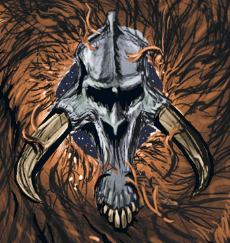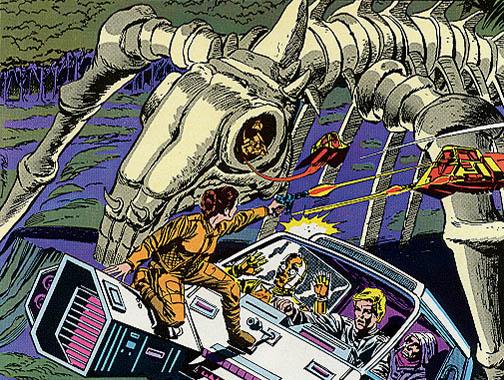Mythosaurs were a non-sentient species native to the Outer Rim planet of Mandalore. Enormous in size, the mythosaurs dominated their world until the arrival of the Mandalorian Taung, led by the warrior known as Mandalore the First. In a campaign to conquer the world for their own, Mandalore the First and his crusaders slaughtered the gigantic beasts and drove them to extinction. The skull of the mythosaur became the symbol of the Mand'alor—the traditional ruler of all the Mandalorian clans—the planet Mandalore, and of the Mandalorians themselves for generations after.
Perhaps the most notable feature of the mythosaur was its sheer size, so enormous that accounts estimated the creatures to be on par with the scale of a small city. Four powerful legs supported what was surely an impressive weight, for a being of similar size to that of a city. Some manner of sexual dimorphism was evident between the skulls of male and female mythosaurs, but in general, the skull of a mythosaur featured large, downturned horns that curved inward toward the creature's jaw, slanted eye sockets, and a mouth that contained a number of long teeth. Mythosaurs also possessed a sternum composed of rigid bone, that was located over their heart.
The Mythosaurs were native to a planet in the Outer Rim uninhabited by any sentient species, and thus their great size afforded them dominion over the other creatures who made the world their home. The mythosaurs roamed the planet's surface unopposed until the day when the Taung arrived on the world around the year 7000 BBY. Immigrating from the planet of Roon, and led by the warrior known as Mandalore the First, the Taung sought to colonize the mythosaur's world as their own. Mandalore the First led a campaign against the giant Mythosaurs, his warriors slaughtering the native beasts using swords and axes as a test of their skills, until they finally drove the creatures to extinction. The Taung then assumed the name "Mandalorians"—or Mando'ade in the Mandalorian language of Mando'a, meaning "Children of Mandalore"—and renamed the conquered world Mandalore in honor of their leader.
The mythosaur skull sigil
Though extinct, the mythosaur lived on as a legendary figure in Mandalorian mythology. The calcified bones of mythosaurs were used by the ancient Mandalorians to construct their first cities and deadly weapons like the mythosaur axe, which used sharpened plates of bone arranged in a fan shape atop an elongated pole grip. Often considered a ceremonial weapon, mythosaur axes were nonetheless used by Mandalorian Crusaders and other veteran warriors in combat for thousands of years. The skull of the mythosaur became a symbol of the planet Mandalore and its people, none more so than the Mand'alor—the traditional ruler of the Mandalorian clans. The rigid bone of a mythosaur's sternum was taken from over one the slain creature's hearts, and carved into a ceremonial mask for Mandalore the First. The mask was later passed down for generations, worn by each succeeding claimant to the title of Mand'alor. The veteran Mandalorian soldier Canderous Ordo was the last known leader to wear the mythosaur-bone mask, during his reign as "Mandalore the Preserver." Even after the use of the ceremonial mask had fallen out of practice, Mandalorians referred to the metaphorical "crown" held by the reigning Mand'alor as the kyr'bes, or mythosaur skull.

The skull of Jaing's species served as the initial inspiration for the skull sigil.
The image of a skull was taken as the sigil of the ancient Mandalorian Keldau clan, renowned for its combat trainers. While the skull sigil was originally based off of the skull of the renowned combat trainer Jaing, the Mandalorians of later times would interpret the sigil as representing a mythosaur skull due to the striking resemblance Jaing's species bore to a male mythosaur. Another iteration of the skull icon was combined with the insignia of the Mandalorian Crusaders to form the crest of the later Neo-Crusaders. The Mandalorian starship company known as MandalMotors also used the skull of the mythosaur as the corporation's logo. In time, the mythosaur skull became a common symbol in Mandalorian society, used to decorate Mandalorian armor, equipment, and banners. Some individuals even chose to don the skull sigil as a tattoo.

The City of Bone, a failed theme park built in the image of a giant mythosaur skeleton
In the final weeks of the Galactic Republic and the early days of its successor state, the Galactic Empire, an enterprising Mandalorian sought to attract adventure tourists to Mandalore to raise a profit. To accomplish his goal, he constructed a large replica of a giant mythosaur skeleton—although its accuracy to scale was debated—on the southern outskirts of Mandalore's capital city, Keldabe. The Mandalorian's theme park ultimately never opened, though he, his brother Hayar, and friend Jarkyc, were able to sell the defunct tourist site to the Imperial garrison that had come to establish a base on Mandalore. The so-called "City of Bone" remained on Mandalore for nearly twenty years, becoming the headquarters of the Imperial slaver, the Suprema, during the Imperial occupation of Mandalore, before being destroyed by Fenn Shysa's Mandalorian Protectors.
Mythosaurs first appeared in the Marvel Star Wars comic, Star Wars (1977) 69, and numerous sources have featured the mythosaurs and provided information since. However, prior to 2013, mythosaurs had never appeared alive in Star Wars, only as skeletons or symbols, primarily as the sigil of the Mandalorian people. That year, with the release of The Bounty Hunter Code: From the Files of Boba Fett—co-authored by Daniel Wallace, Jason Fry, and Ryder Windham—came the first depiction of a living mythosaur.
Contrary to other sources, Abel G. Peña's Star Wars Insider article The History of the Mandalorians establishes that the Mandalorian crest only resembles a skull of a male mythosaur, and was actually adopted in reverence of a Mandalorian combat-training master, Jaing.
- "The History of the Mandalorians" — Star Wars Insider 80
- The New Essential Chronology
- Star Wars: Empire at War: Forces of Corruption Expansion: Prima Official Game Guide
- Aliens in the Empire, Part 1: Hierarchy of Power on Hyperspace
- Knights of the Old Republic Campaign Guide
- The Complete Star Wars Encyclopedia
- The Essential Atlas
- The Bounty Hunter Code: From the Files of Boba Fett